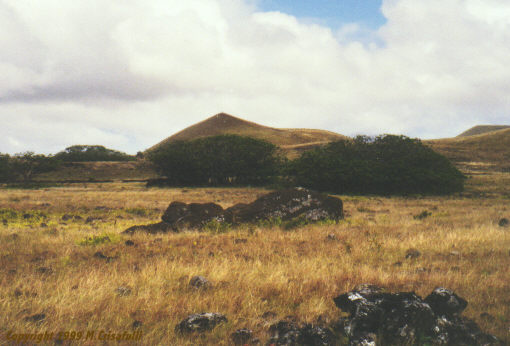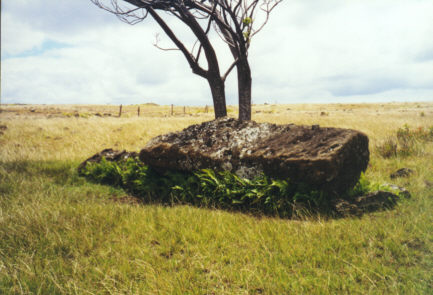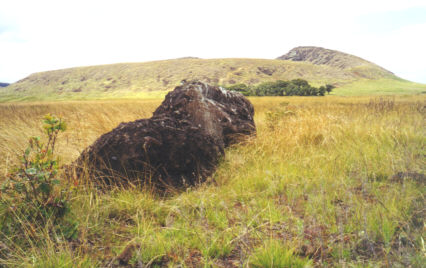
An Afternoon's Exploration and Discoveries
As a member of the survey team I was free on our last afternoon in the field. In two weeks we'd covered the entire survey area and more. Now, Chris and the measuring team would finish up the last few sites and features we'd flagged. We were on the southern edge of the area and Rano Raraku looked especially close. I decided it would be easy to walk there and back in the several hours until we returned to town.
| Although I started with one eye behind me, looking for landmarks to make my way back, I was soon pleasantly startled to find the giant pictured at right lying before me. I came upon him looking at his base, but the color of the stone made it clear this was a moai, and a huge one. I paced off the length and scribbled these notes: "moai, ~9 m, lying on back, no indication of ahu, broken in several places". I also noted that its head lay toward the statue quarry. Subsequent measurement would show I underestimated my stride. The moai was 11.2 meters long, taller than the tallest ever erected on an ahu. |  |
 |
With my attention raised
I continued toward my destination, and soon came upon another moai,
this one lying prone. It was tilted slightly by the small trees
growing alongside. Like the other, it was not in good condition, its
head detached, but was aligned so the head faced away from the
quarry. I measured the moai later at 5.3 meters. This was becoming
a more interesting walk than I had anticipated. What next?
Some distance further I found an apparent large but crude ahu. There were several small fragments of the yellow tuff characteristic of moai, but nothing large or recognizable. There was the foundation of a rectangular chief's house next to the west end of the structure. |
| Continuing on my way, I soon saw a third moai before me. The alignment, head lying away from the quarry crater seen in the background, is clear in the photo at right. It lay on its side and is 5.8 meters long. By now I was thinking of a moai road, one of the paths along which the Rapa Nui hauled the statues to their destination ahu. None of these moai had the carved eyes found on those situated on ahu, and they lay in a fairly straight line starting at the western side of the crater and going north and slightly west into the the La Perouse area. Beside the three pictured here there was a fourth very close to the quarry. That one is about five meters long, lying prone next to a modern stone wall running to the right from the distant grove of trees in the picture at right. |  |
Chris had pointed out the main moai
road running along the southern coast, when we visited Rano Raraku, and
mentioned the existence of others. I began
researching the known roads on my return home. Browsing the PBS Nova
web site I chanced on a map of Easter Island that appeared to show the moai I
describe above. There was also a reference by Dr. Joanne
Van Tilburg to "known transport roads".
Her response to my e-mail query speculated I was on the
northern statue road between Rano Raraku and La Perouse, and recommended
I check Katherine Routledge's book The Mystery of Easter
Island. Routledge spent some time on Easter Island at the
beginning of this century and performed the first systematic archaeology
there. This text in the section titled "Ancient
Roads" (p.195) confirmed the speculation:
| "The third road, which runs from Raraku in a northerly direction, is much shorter than those to the south and west. It has only four statues covering a distance of about a mile, and then it disappears... The furthest of the images is the largest that has been moved; it lies on its back, badly broken, but the total of its fragments gives a height of thirty-six feet four inches." |
This page and its contents © Copyright 1999 Michael & Karen Crisafulli. All rights reserved.